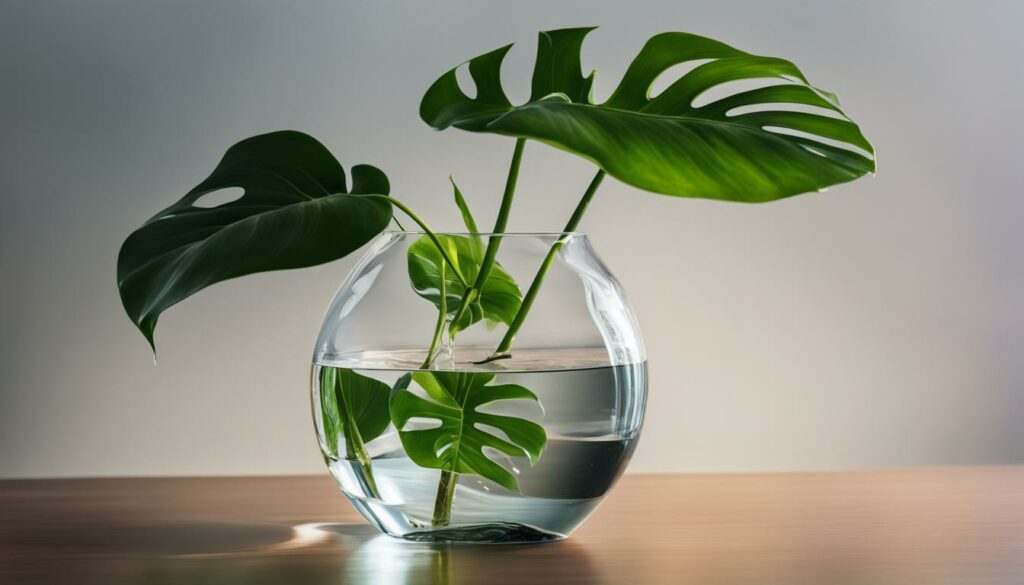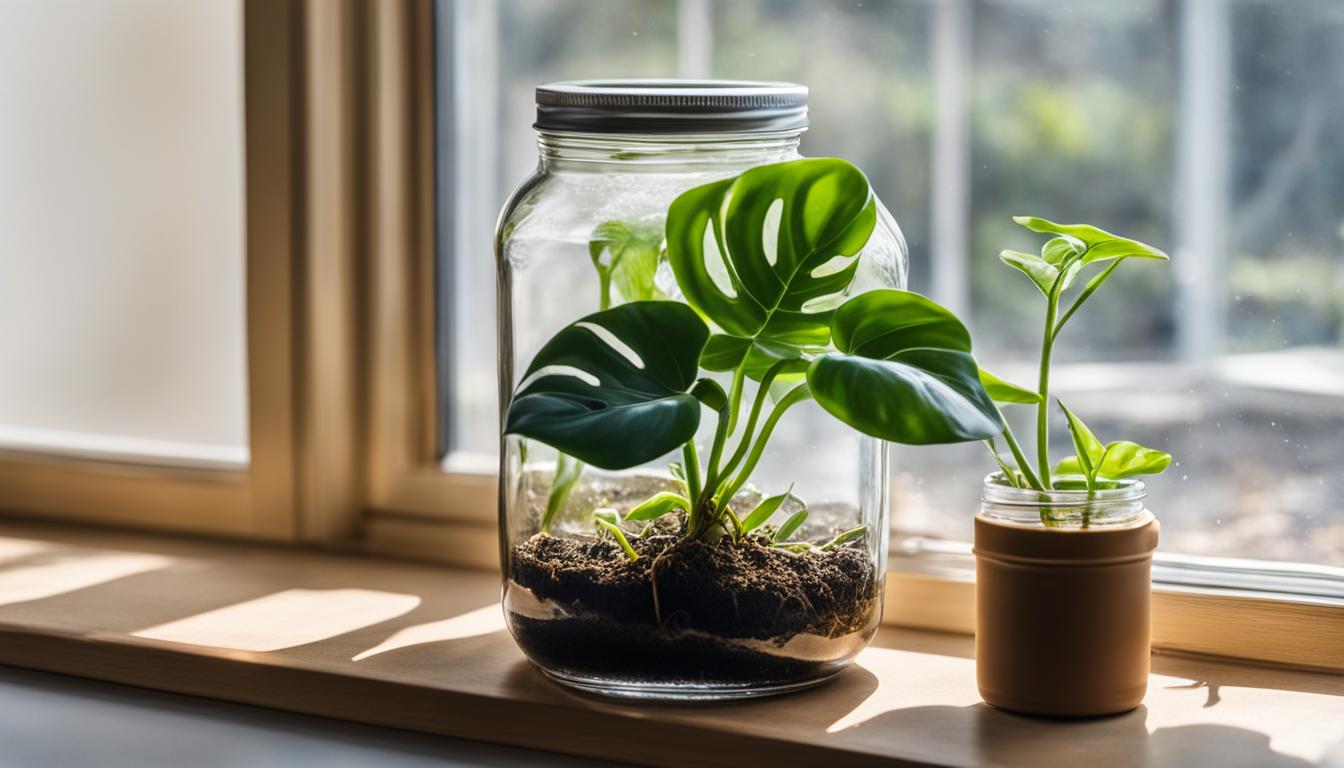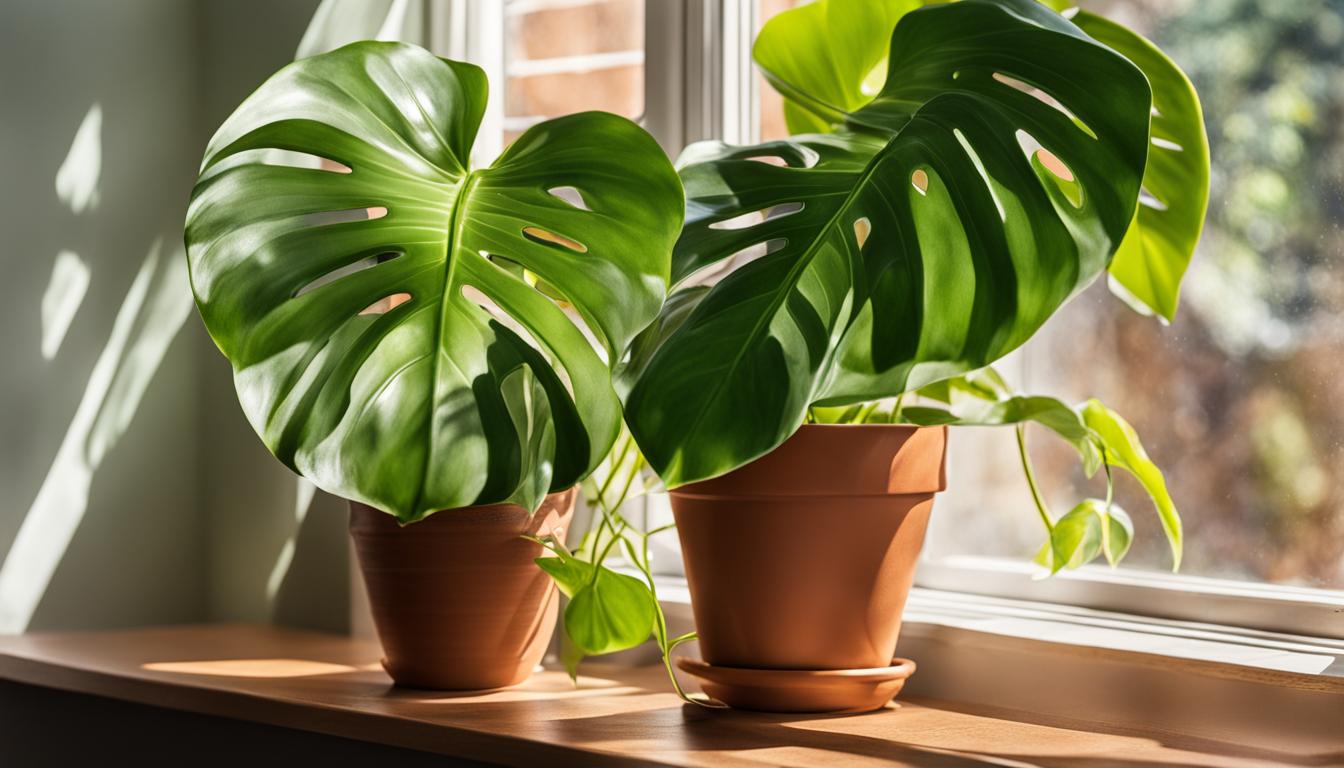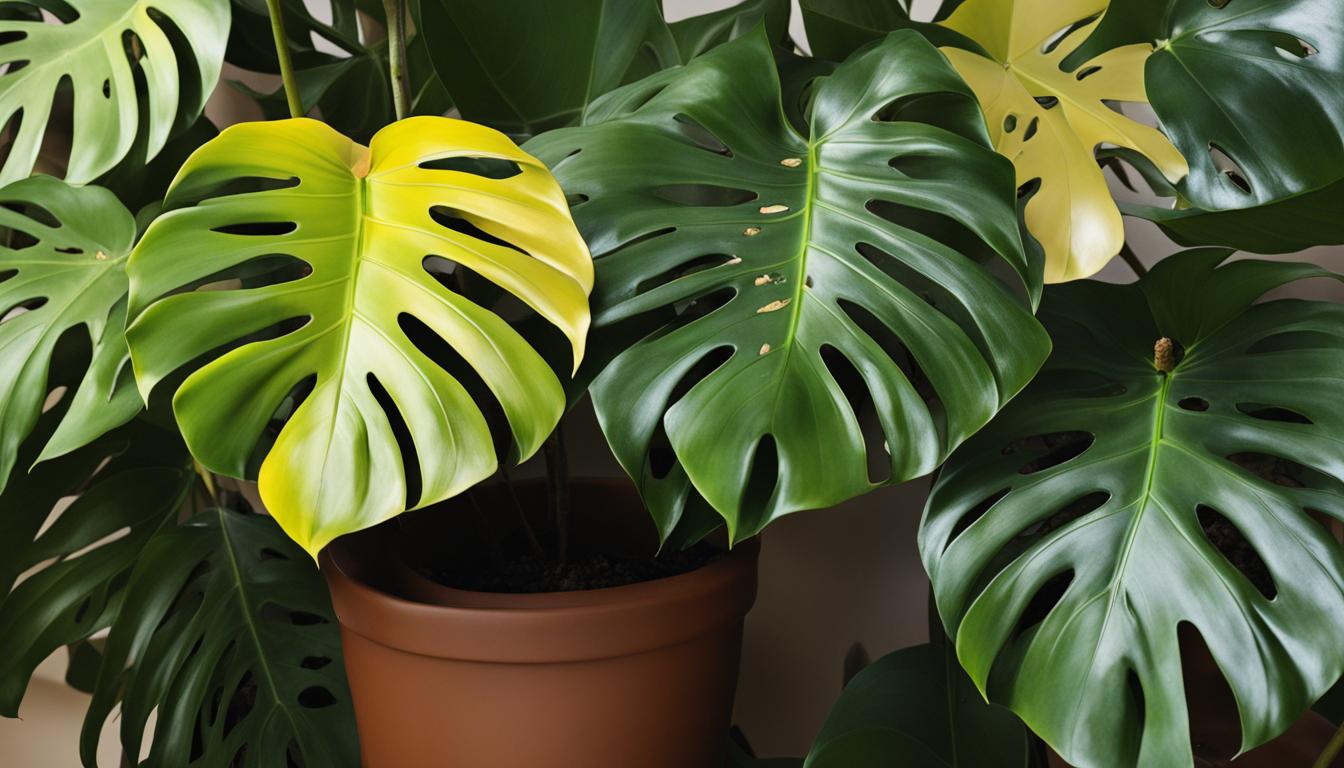Welcome to our comprehensive Monstera propagation guide! If you’re a plant enthusiast looking to expand your collection, you’ve come to the right place. In this article, we’ll show you how to propagate Monstera plants with ease. Whether you’re a beginner or an experienced gardener, we have tips and techniques that will help you succeed.
Monstera deliciosa, also known as the Swiss cheese plant, is a stunning houseplant with large, tropical foliage. It’s a popular choice among plant lovers for its unique and beautiful leaves. If you want to learn how to propagate this amazing plant, keep reading for our expert tips and step-by-step instructions.
Propagation can be done through stem cuttings, air layering, or root division. Each method has its own advantages and considerations. We’ll delve into each technique, providing detailed notes and insights along the way.
By the end of this guide, you’ll have the knowledge and confidence to successfully propagate your Monstera plants. Get ready to grow your plant family and enjoy the beauty of Monstera’s lush foliage in every corner of your home!
Understanding Monstera Deliciosa
Monstera deliciosa, also known as the Swiss cheese plant or Mexican breadfruit, is a stunning tropical houseplant that has captured the hearts of indoor gardeners. With its large, glossy, heart-shaped leaves adorned with intricate perforations and deep lobes, this plant adds a touch of exotic beauty to any space. Native to Central America, Monstera deliciosa has become a popular choice for plant enthusiasts around the world.
One of the striking characteristics of Monstera deliciosa is its ability to climb and attach itself to tree trunks using its aerial roots. In its natural habitat, it can reach impressive heights of more than 50 feet, creating a lush and dramatic presence. As a houseplant, it can be trained to grow on support structures or allowed to trail and cascade from hanging baskets, showcasing its unique foliage.
In addition to its visual appeal, Monstera deliciosa is also known for its ability to purify the air by removing harmful toxins. This makes it not only a beautiful addition to your home but also an excellent choice for improving indoor air quality. With proper care and attention, this extraordinary plant can thrive and bring a touch of the tropical paradise into your living space.
Propagation Methods for Monstera Deliciosa
When it comes to propagating Monstera deliciosa, you have several methods to choose from: stem cuttings, air layering, and root division. Each method has its own advantages and can be successful with the right technique. Let’s take a closer look at these propagation methods:
Stem Cuttings
Stem cuttings are a popular and straightforward way to propagate Monstera deliciosa. To start, choose a healthy stem with at least one node, as this is where the new roots will form. Cut the stem just below a node and remove any lower leaves. Place the cutting in a jar of water, making sure the node is submerged. Change the water every few days to keep it fresh. Within a few weeks, you should start to see roots forming. Once the roots are well-developed, you can transfer the cutting into a pot with well-draining soil.
Air Layering
Air layering is a slightly more advanced method of propagation that involves encouraging roots to develop on a section of the stem before separating it from the parent plant. To air layer a Monstera deliciosa, make a small incision in the stem below a node, taking care not to cut all the way through. Insert a toothpick or a small piece of wood into the incision to keep it open. Wrap the area with moist sphagnum moss or a similar medium, and cover it with plastic wrap to retain moisture. Over time, roots will form in the moss. Once the roots are well-established, you can cut below the air layer and pot it up as a new plant.
Root Division
Root division is ideal for mature Monstera deliciosa plants that have become overcrowded or need rejuvenation. It involves carefully separating the plant into multiple sections, each with its own root system. To do this, carefully remove the plant from its pot and gently separate the roots, ensuring that each section has a good amount of roots and stems. Plant each section in its own pot with well-draining soil, and water thoroughly. This method allows you to create multiple new plants from a single specimen.
By using these propagation methods, you can easily expand your Monstera deliciosa collection and share the joy of growing these beautiful plants with others. Whether you prefer stem cuttings, air layering, or root division, experimenting with different techniques can be a fun and rewarding journey in the world of plant propagation.
Water Propagation for Monstera Plants
Water propagation is a simple and effective method for propagating Monstera plants. It allows you to easily observe root development and ensures a higher success rate for propagation. To propagate your Monstera plant in water, follow these steps:
- Take a stem cutting with at least one node. Nodes are essential for root development.
- Fill a clean jar with filtered water and place the stem cutting in the jar, ensuring that the node is submerged.
- Place the jar in a bright location, but avoid direct sunlight as it can cause algae growth in the water.
- Change the water every few days to prevent bacterial and fungal growth. This helps maintain a healthy environment for root development.
- Consider adding a rooting hormone to the node to promote faster root growth. Rooting hormones contain auxins, which stimulate root development.
- After a few weeks, you should see roots starting to grow from the node. Once the roots are at least an inch long, you can transfer the cutting to a potting soil mixture for further growth.
Water propagation is a great method for beginners or for those who want to enjoy the process of watching the roots grow. Additionally, it allows you to easily monitor the health of the roots and ensure they’re developing properly before transplanting the cutting into soil.
Water propagation is a popular method for propagating Monstera plants because it is relatively easy and provides quick results. The process of observing the roots growing in water can be exciting and gratifying. However, it’s important to note that not all plants will successfully root in water, so it’s always a good idea to experiment with multiple cuttings to increase your chances of success.
Table: Pros and Cons of Water Propagation for Monstera Plants
| Pros | Cons |
|---|---|
| Easy to observe root development | Not all plants will successfully root in water |
| Higher success rate for propagation | Algae growth in the water if exposed to direct sunlight |
| Roots can be easily monitored for health | Requires regular water changes to prevent bacterial and fungal growth |
| Allows for faster root growth with the use of rooting hormone | Transplanting cutting to soil can be delicate |
Overall, water propagation is a popular and effective method for propagating Monstera plants. It offers beginners an accessible way to expand their plant collection and allows for easy observation of root development. Experiment with water propagation and enjoy the rewarding process of seeing your Monstera cuttings develop into healthy plants.

Soil Propagation for Monstera Plants
Soil propagation is a popular and effective method for propagating Monstera plants. It involves taking a stem cutting with a node and planting it in a well-draining potting soil mixture. The potting soil should be moist but not soggy, as excessive moisture can lead to root rot. It’s important to choose a potting soil that is rich in organic matter and provides good aeration for the roots to grow.
When propagating Monstera plants in soil, it’s crucial to water the cutting thoroughly after planting. This helps to settle the soil around the roots and ensures that the cutting receives enough moisture to support growth. However, it’s also important not to overwater the plant, as this can lead to root rot. Allow the top few inches of soil to dry out between waterings, and adjust the watering frequency based on the moisture level of the soil.
Maintaining a bright, indirect light environment is key for the successful propagation of Monstera plants in soil. Place the cutting in a location that receives bright, filtered light, but avoid exposing it to direct sunlight, as this can scorch the leaves. Providing the right amount of light will help the cutting develop strong roots and stimulate the growth of new leaves.
In summary, soil propagation is a popular and effective method for propagating Monstera plants. By following the proper planting techniques, watering practices, and providing the right light conditions, you can successfully propagate Monstera plants in soil and enjoy the growth of new leaves and roots.
Air Layering for Monstera Plants
Air layering is an advanced method of propagating Monstera plants that involves creating a wound on the stem and encouraging the development of roots before separating the new plant. This technique allows you to produce a rooted plant while it is still attached to the parent plant, ensuring a higher success rate compared to other propagation methods.
To begin air layering, select a healthy stem that is at least 1/4 inch thick and has several nodes. Make a vertical cut around 1 inch long just below a node, then carefully remove the bark and any other tissue down to the wood. This exposes the cambium layer, which is where the roots will form.
Next, apply a moist, moisture-retaining medium such as sphagnum moss or compost around the wounded area. Wrap the medium with plastic wrap or a plastic bag to maintain humidity, making sure to seal the top and bottom of the wrapping. Check the moisture level regularly and mist if necessary to keep the medium consistently moist.
Expert Tip: It’s important to choose a moisture-retaining medium that holds water well but also allows for aeration. This creates an optimal environment for root development.
After a few weeks, you should start to see roots forming within the moss or compost. Once a sufficient amount of roots have developed, carefully cut below the rooted section and remove it from the parent plant. Plant the new Monstera plant in a well-draining potting mix and provide it with the appropriate care to promote further growth.
Air layering is a great option if you want to propagate your Monstera plant without cutting it from the parent plant. It can also be useful for creating new plants from specific sections of the parent plant, allowing you to selectively propagate desirable traits. With patience and proper care, air layering can be a successful method of expanding your Monstera collection.

Table: Pros and Cons of Air Layering
| Pros | Cons |
|---|---|
| Higher success rate compared to other methods | Requires more time and patience |
| Allows propagation without cutting from parent plant | Requires more skill and experience |
| Can selectively propagate desirable traits | May not be suitable for all plant varieties |
| Produces a fully rooted plant | Requires careful monitoring of moisture levels |
Conclusion
Propagating Monstera plants is a fun and cost-effective way to expand your plant collection. By following the proper techniques and providing the right conditions, you can increase the success rate of propagation. Whether you choose stem cuttings, air layering, or root division, each method has its own benefits and considerations.
Stem cuttings are a versatile option that can be done at any time of the year, while air layering offers a more advanced approach for experienced plant enthusiasts. Root division is suitable for large, overgrown plants that need to be divided. It’s important to be patient throughout the process, as it may take several weeks or months for new roots and growth to occur.
Remember to provide adequate care and attention to your propagated Monstera plants. Maintain proper watering and lighting conditions, and keep an eye out for any signs of pests or diseases. With time and effort, you’ll soon have a new batch of Monstera plants to enjoy in your home, creating a lush and tropical atmosphere.
FAQ
Can Monstera deliciosa be propagated through stem cuttings?
Yes, stem cuttings are a common method for propagating Monstera plants. Take a cutting with a node and place it in water or soil to encourage root development.
How long does it take for Monstera cuttings to develop roots?
It can take several weeks or even months for Monstera cuttings to develop roots and start growing new leaves. Patience is key during the propagation process.
What is the best environment for Monstera cuttings to grow?
Monstera cuttings thrive in bright, indirect light. Make sure to provide them with a well-draining potting soil mixture and water them thoroughly, allowing the top few inches of soil to dry out between waterings.
Can Monstera deliciosa be propagated through air layering?
Yes, air layering is another method for propagating Monstera plants. It involves creating a wound on the stem, wrapping it with a moisture-retaining medium, and allowing roots to develop before separating the new plant.
How long does it take for roots to form in air layering?
The time it takes for roots to form in air layering can vary, but it usually takes several weeks for roots to develop. Regularly check the moisture level of the medium and ensure it stays moist.
Is water propagation a suitable method for Monstera propagation?
Yes, water propagation is a popular and effective method for propagating Monstera plants. Simply take a stem cutting with a node, place it in a jar of filtered water, and change the water every few days to prevent bacterial and fungal growth.
Can Monstera plants be propagated through root division?
Yes, root division is suitable for large, overgrown Monstera plants. It involves dividing the root system into separate plants to encourage new growth.
What is the success rate of Monstera propagation?
The success rate of Monstera propagation can vary depending on the method used and the care provided. By following the proper techniques and providing the right conditions, you can increase the chances of successful propagation.



